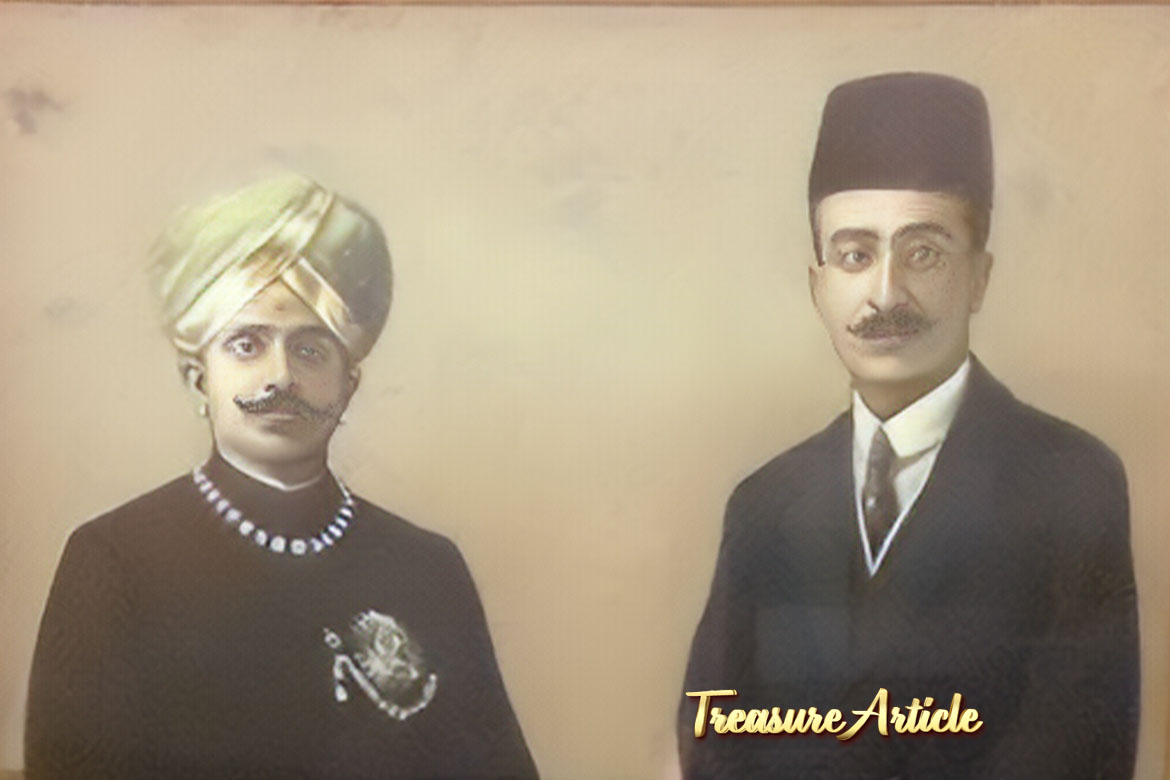
In the 20th Century, a farsighted Diwan (Head of the state) of the then regal and princely State of Mysore, Sir Mirza Mohammed Ismail, KCIE, OBE, LLD, knight (1883-1959) wrought a revolution as a Dewan (Prime Minister) in 3 Indian princely States; Mysore (1926-41), Jaipur (1942-46) and Hyderabad (1946-47). Sir Mirza Ismail reformed and industrialized the states, modernized the administration, beautified, and planned their capital cities, emphasized modern education and Health sector with extraordinary growth and prepared them to be independent of the clutches of the British Empire. Today In both Jaipur City and Mysore City, there are roads named after Sir Mirza Ismail.
Sir Mirza Ismail was named ‘Amin-ul-Mulk’ ad much that volumes have been written on this able administrator’s contribution to Mysore State (today’s Karnataka State) in his capacity as one of the “Navaratna” of Maharaja Krishnaraja Wadiyar IV of the Wadiyar dynasty.
Sir Mirza Ismail son of Aga Jan (aide-de-camp to Maharaja Sri Chamaraja Wadiyar X) and Grandson to Aga Ali Asker Shirazi a Horse merchant known as the ‘Jaghirdar’ of high ground, being the largest landowner of Bengaluru and brain behind many architecturally-rich heritage structures in Bengaluru, including the Balabrooie (State Guest House) and Governor’s Residence. It is said that he built about 100 bungalows. Sir Mirza Ismail was born in Bengaluru, a resident of Richmond Town, and had his schooling at St. Patricks School and the Wesleyan Mission School.
Sir Mirza Ismail, an invincible Administrator (former Dewan of Mysore), and a magnificent kind-hearted leader of great brilliance has almost been forgotten today, but a giant of those times with a national reputation as an ardent patriot, a pioneer, sagacious statesman, visionary and highly knighted by the British Government for his services to India.
A well-renowned stalwart writer & poet of Karnataka Sri D V Gundappa (DVG) says: “The yearly tribute paid to the British Government by the Mysore state was Cut/removed by Sir Mirza Ismail the Prime Minister of Mysore. And strived & launched Atma Nirbhar Mysore & Swacchh Mysore in his period and many more projects.”
An article in the New York Times in 1942 remarked that Jaipur had been a picture of neglect, but after two years of Sir Mirza Ismail’s sojourn, it was “more thoroughly transformed and improved than New York after Robert Moses got through with it.”
The tenure of Sir Mirza Ismail was a glorious period and the reason why Karnataka is a hub for science and technology is because of Sir Mirza Ismail and Sir M Visvesvaraya. The fact that Bengaluru became the Silicon Valley of India’s global innovation centre is because of the foundation laid out by them.
Sir Mirza Ismail launched phenomenal programs: on education, agriculture, and commercial enterprises, more than 25 different industries/factories started in his period, including Iron, Steel, glass, lamp, sugar, paper, Cement, chemical, electric bulbs, Porcelain, fertilisers, Aircraft, agricultural implements, Mysuru Kirloskar machine shop, Oil mills, Soap units, Sawmills, Match-Stick factory, Khadi production, Coffee curing works were also established (Mysore pro- duces 60 per cent of India’s coffee), a factory manufacturing Colour Coated Aluminium, Nylon Textile factory, etc. His period saw Mysore State make substantial progress in the field of industries, both in the private and public sectors.
Sir Mirza Ismail launched Rural electrification (Mysore was the first state in India to supply electricity to 500 villages). His most memorable contribution to Bengaluru is the supply of drinking water from Thippagondanahalli.
Sir Mirza Ismail promoted the silk and sandalwood industries. He took charge of the development of Wilson Garden, Kalasipalyam, Gandhinagar, N.R.Colony, the Labour colony in Srirampura and the Dattatreya extension in Chamarajapete, among many others. He Initiated small-scale industries and scrutinized heavy investment projects, and Unemployment became a thing of the past.
Sir Mirza Ismail took several measures to promote literacy and established and commissioned many Schools, Colleges, Medical Colleges and Universities. The greatest scientist of India Nobel Laureate Sir C. V. Raman considered Sir Mirza Ismail his mentor. Sir Mirza Ismail played the most important role in establishing an organization like Sanskrit College, Indian Institute of Science (IISC) Bengaluru, in the then Mysore state, Raman Research Institute and Birla Institute of Technology and Sciences (Bits) in Pilani. On the death of Sir Mirza Ismail, C. V Raman wrote in Current Science, a scientific journal, “Men of Science in India have therefore good reason to be grateful to Sir Mirza Ismail for his farsighted wisdom.”
Sir Mirza Ismail worked for the upliftment of villages, and built many Hospitals, founded NIMHANS in Bengaluru, Narasimharaja Hospital in Kolar, McGann Hospital in Shimoga and Vanivilasa Hospital in Mysore. Built many Markets, asphalted many good roads, and introduced Bus transportation, Bus Stations, and Akashvani Radio stations, building new railway lines and Airports. Built the Iconic Town Hall, Banks, Hindustan Aeronautics Limited (HAL), hydroelectric stations at Shimsha and Jog falls, and irrigation facility to Mandya, Malavalli T.Narsipura (Irwin Canal) areas. His most cherished contribution is the laying of parks, gardens, beautiful squares in towns and Brindavan Gardens at KRS dam, Lalbagh. He planted trees and streets lit with chandelier lamp posts all over Bengaluru. His Light taxation, minimal interference in the lives of its people and commitment to an environment of progress and prosperity were the hallmarks.
A Shia Muslim by birth, he consistently supported Sanskrit learning including pro-Kannada literature works, many programs he did for language and mandated the Kannada language in the state. He is also responsible for the development of Kannada Sahitya Parishath, Hindu Mutts and Christian institutions; in his own words: “One pleases the Almighty even more by serving other faiths than one’s own”.
Sir Mirza Ismail treated the interest of the ‘common’ as a supreme duty. His style of administration was participatory and practical. He was a people man. He was very thoughtful towards his citizens. He began ‘meet individuals’ meetings two times every week where the average person could meet him and educate him regarding their difficulties. It was likewise a way to check corruption in the higher ranks. He likewise reviewed the city week after week, visiting individuals from all networks and hearing their concerns. He had organized water pipelines and other fundamental necessities for their families.
Sir Mirza Ismail’s uprightness and obligation to public assistance propelled numerous humanitarians to give cash for the development of dispensaries (Clinical facilities) in the city for the free treatment of poor people.
Sir Mirza Ismail penned his memoir My Public Life published in 1954. Sir Mirza Ismail was an unequivocal opponent of the partition of India and the creation of Pakistan but advocating for an entire sub-continent that included Nepal, Burma and Srilanka (for an Undivided India AKHAND BHARAT),” said a history professor Mr Shalva Pille Iyengar. And many more pathbreaking policies, projects, and schemes gave Karnataka its golden era during the turbulent pre-independence/partition, prompting Mahatma Gandhi to call it “Ram Rajya. And Lord Sankey, the Chairman of the Indian Round Table Conference, spoke of Mysore as “A Pattern for the World” during the tenure of Sir Mirza Ismail the then Dewan of Mysore state.
A close friend and admirer of Mahatma Gandhi, after Gandhi’s fast for peace in Calcutta in September 1947, Sir Mirza Ismail wrote to him; “You are rendering the greatest possible service to India in her most trying time. Your moral influence on all communities; Hindu, Muslim, Christian, Sikh, alike on all races, whether in or outside India, is at its highest today.”
Sir Mirza Ismail’s Awe-Inspiring, Striking and Pathbreaking contributions should not be, lost in the annals of history. This Iconic story should be told, esteemed, valued, appreciated, and ought to be all around regarded and well-honoured in Bengaluru City and India. Although Sir Mirza Ismail may not live among us, his never-ending heritage and legacy lives and history will always remember him.
References:
My Public life – Sir Mirza Ismail
D V Gundappa’s – Magnum-opus Jnapakachitrashaale (Vol: 4)
Wikipedia.org




No Comments